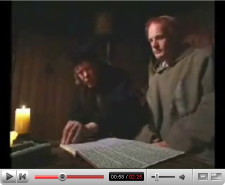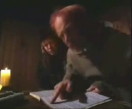 On the forum of our MRes course at Lancaster one of the students posted a link to Middle Ages Tech Support on YouTube. It shows Ansgarr a Mediaeval monk struggling with his first book.
On the forum of our MRes course at Lancaster one of the students posted a link to Middle Ages Tech Support on YouTube. It shows Ansgarr a Mediaeval monk struggling with his first book.
I first saw this video when I was giving a talk at University of Peloponnese in Tripolis. Georgios1 showed the video before I started, just because he thought it was fun. I was talking a little bit about physicality and the video brought up some really interesting issues relating to this and usability. Although it is a comic video we can unpack it and ask which of the problems that Ansgarr has as he changes technology from scroll to book would actually happen and which are more our own anachronistic view of the past.
The video starts with the technician coming in and Ansgarr. The technician asks if Ansgarr has been able to “open it”, Ansgarr says if it was that simple he wouldn’t have called the help desk. However, it turns out afterwards that he has managed to get as far as opening the book. Just like today the language used gets in the way: what does “open it” mean to a user?
It is interesting and quite reasonable that Ansgarr was able to open the book (even if he didn’t know he was doing so), because it requires little experimentation or playing with the book to open it. To know that the text starts at one end, that pages are read left to right are all clearly cultural knowledge that we do have to learn; but the fact that it can be opened is easily discoverable due to its physical nature.
However, Ansgarr has not proceeded further for fear of losing the text he has read. Just as with current technology, the Mediaeval child playing with the book might have had less problems here than the older monk. Designing to reduce fear is a major issue if we wish to engage those out of their teens. It would be nice to say this is just about perception it is hard to do real damage in most computer applications … but try saying that to the embarrassed lady who accidentally deleted a whole shared photo gallery when she meant to delete a single photo (recovering this took Fiona and I most of last night!).
 The next part of the video has Ansgarr being shown how you turn very pages to see more text. This again I can see would not be obvious, and even less obvious that the text that ended at the bottom of the right-hand page continues at the top of the left-hand one.
The next part of the video has Ansgarr being shown how you turn very pages to see more text. This again I can see would not be obvious, and even less obvious that the text that ended at the bottom of the right-hand page continues at the top of the left-hand one.
Even worse must have been the cognitive shift from scrolls, where you could always see the context of what you were reading, to books, where you are trying to read the end of a sentence at the top of one page when the start of it is no longer visible. We take this for granted, but even for modern readers I’m sure there can be some interesting errors that occur as one reads across page-ends, just like the well known line-end effects:
Paris in
in the spring
After the page is turned, Ansgarr asks how he can see the text that he has previously read. the technician patiently explains how he can turn the page back over and Ansgarr is pleasantly surprised to see that the text is still there. Now this is exactly a point of digital anachronism. In Digital media it is by no means certain that of one goes back to where one was previously things will be the same. But the physical world is usually far easier; if you turn something over and then turn it back you expect to see what was there previously. Here is a clear place where we can ask how we can recreate some of this clarity of the physical world in the digital – how to exploit the power of dynamic content whilst preserving the intelligibility of more static invariants.
Finally the book is closed, Ansgarr goes back through the process: opens the book, skims the pages and closes it – he is satisfied, but as the technician leaves the room he finds he is stuck again and cant open the book. It turns out that it is upside down and he is trying to open it along the spine.


I am sure that left to his own devices Ansgarr would have found out that he could open the book at the left-hand side and worked from there. However, this again reveals a common problem today. The back of the book looked just like the front … and the tick box to “delete album” looked so so similar to “delete photo”.
- one of my hosts there as part of the TIM project[back]

Pingback: Alan’s blog » tales from/for Berlin - appropriation, adoption and physicality